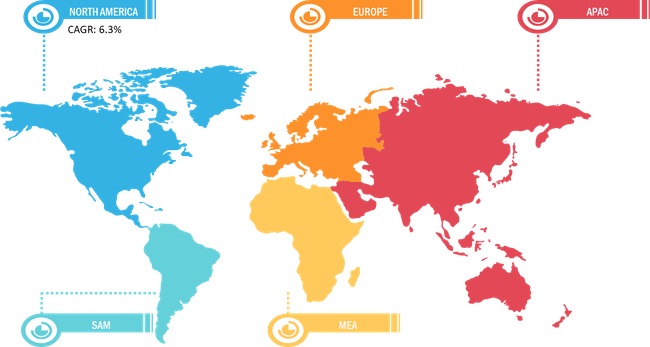Increasing Health Awareness Among Consumers Drives Frozen Seafood Market Growth
According to our latest market study, titled “Frozen Seafood Market Forecast to 2028 – COVID-19 Impact and Global Analysis – by Type (Frozen Fish, Frozen Crustaceans, Frozen Mollusks, and Others), Distribution Channel (Supermarket and Hypermarkets, Specialty Stores, Online Retail, and Others), and Geography,” the global frozen seafood market is projected to reach US$ 22.57 billion by 2028 from US$ 16.27 billion in 2022. It is expected to grow at a CAGR of 5.6% during 2022–2028. The report highlights key factors driving the frozen seafood market growth and prominent players along with their developments in the market.
Over the past few years, the preference for healthy living increased dramatically. People do not want to compromise their health in their busy lifestyle, which leads to increasing demand for convenient food products to provide better health benefits to the human body. Seafood contains vitamins, nutrients, calcium, minerals, phosphorus, and omega-3. People are increasingly consuming seafood as it provides various health benefits.
Health consciousness has been increasing among the young population. The increasing popularity of fitness and muscle building among the millennials, coupled with their interest in following a balanced diet, are expected to create additional demand for seafood products over the forecast period. Fresh seafood products have a shorter shelf life and are relatively expensive, whereas, frozen seafood products are affordable and can be stored for a longer duration. Thus, the factors mentioned above are driving the market growth.
Frozen seafood products are available in different varieties, all year-round, with various health benefits. Seafood products reduce the risk of heart attacks and strokes and improve brain health, eyesight, and immune system. Moreover, frozen seafood products are packaged, easy to cook, save time, and avoid wastage. Manufacturers of frozen seafood products are launching innovative products with high nutrient value and packaging to attract many customers. Thus, all these factors are contributing to the frozen seafood market growth.
Thai Union Group, Sterling Seafood Corp., Clifton Seafood Company, Marine Foods, Viet Asia Foods Company, American Seafoods, Mazetta Company LLC, High Liner Foods Inc, The Sirena Group, and Castlerock Fisheries Pvt. Ltd. are the key players operating in the global frozen seafood market. These companies provide a wide range of products for the market and have a widespread global presence, which provides a lucrative opportunity to serve a large set of customers.
Impact of COVID-19 Pandemic on Frozen Seafood Market
The COVID-19 pandemic initially affected the global frozen seafood market due to the shutdown of manufacturing units, rising seafood prices, shortage of labor, disruption of supply chains, and financial instability.
The food & beverage industry's disruption due to the economic slowdown caused by the COVID-19 outbreak restrained the demand for frozen seafood. However, businesses are gaining ground as previously imposed limitations have been eased across various countries. Moreover, the introduction of COVID-19 vaccines by governments of different countries eased the situation, leading to the rise in business activities worldwide. The COVID-19 pandemic also collaterally resulted in the growth of several segments of the food & beverage industry post recovery from the production disruptions. The COVID-19 pandemic led people to stay at home for a long time, under quarantine or otherwise, which increased the focus on at-home cooking. As people have been working from home, emphasis on cooking at home and consuming foods with high nutrient values increased.
Global Frozen Seafood Market Breakdown – by Region
Frozen Seafood Market Forecast to 2028 - COVID-19 Impact and Global Analysis By Type (Frozen Fish, Frozen Crustaceans, Frozen Mollusks, Others), Distribution Channel (Supermarket and Hypermarkets, Specialty Stores, Online Retail, and Others), and Geography
Frozen Seafood Market SWOT Analysis by 2028
Download Free Sample
The report includes the segmentation of the global frozen seafood market as follows:
Based on product type, the market is segmented into frozen fish, frozen crustaceans, frozen mollusks, and others. Based on distribution channel, the market is segmented into supermarkets and hypermarkets, specialty stores, online retail, and others.
By geography, the frozen seafood market is broadly segmented into North America, Europe, Asia Pacific (APAC), the Middle East & Africa (MEA), and South and Central America. The market in North America is further segmented into the US, Mexico, and Canada. The Europe market is segmented into Germany, France, Italy, the UK, Russia, and the Rest of Europe. The market in Asia Pacific is segmented into Australia, China, India, Japan, South Korea, and the Rest of Asia Pacific. The market in the Middle East & Africa (MEA) is further segmented into South Africa, Saudi Arabia, the UAE, and the Rest of the MEA. The market in South and Central America is segmented into Brazil, Argentina, and the Rest of South and Central America.
Contact Us
Phone: +1-646-491-9876
Email Id: sales@theinsightpartners.com